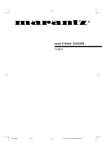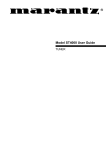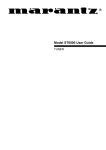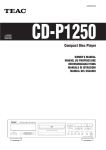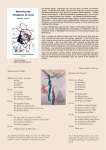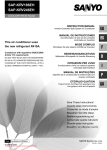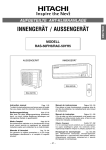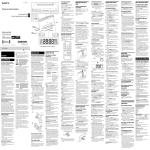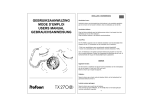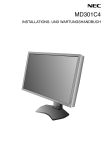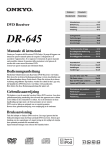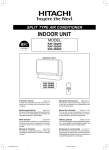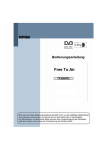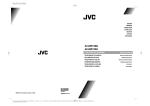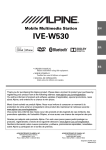Download User Guide - Performance Audio
Transcript
Model PMD800 User Guide TUNER R CAUTION RISK OF ELECTRIC SHOCK DO NOT OPEN CAUTION: TO REDUCE THE RISK OF ELECTRIC SHOCK, DO NOT REMOVE COVER (OR BACK) NO USER-SERVICEABLE PARTS INSIDE REFER SERVICING TO QUALIFIED SERVICE PERSONNEL The lightning flash with arrowhead symbol within an equilateral triangle is intended to alert the user to the presence of uninsulated “dangerous voltage” within the product’s enclosure that may be of sufficient magnitude to constitute a risk of electric shock to persons. The exclamation point within an equilateral triangle is intended to alert the user to the presence of important operating and maintenance (servicing) instructions in the literature accompanying the product. WARNING TO REDUCE THE RISK OF FIRE OR ELECTRIC SHOCK, DO NOT EXPOSE THIS PRODUCT TO RAIN OR MOISTURE. CAUTION: TO PREVENT ELECTRIC SHOCK, MATCH WIDE BLADE OF PLUG TO WIDE SLOT, FULLY INSERT. ATTENTION: POUR ÉVITER LES CHOC ÉLECTRIQUES, INTRODUIRE LA LAME LA PLUS LARGE DE LA FICHE DANS LA BORNE CORRESPONDANTE DE LA PRISE ET POUSSER JUSQU’AU FOND. NOTE TO CATV SYSTEM INSTALLER: This reminder is provided to call the CATV (Cable-TV) system installer’s attention to Section 820-40 of the NEC which provides guidelines for proper grounding and, in particular, specifies that the cable ground shall be connected to the grounding system of the building, as close to the point of cable entry as practical. NOTE: - Reorient or relocate the receiving antenna. This equipment has been tested and found to comply with the limits for a Class B digital device, pursuant to Part 15 of the FCC Rules. These limits are designed to provide reasonable protection against harmful interference in a residential installation. This equipment generates, uses and can radiate radio frequency energy and, if not installed and used in accordance with the instructions, may cause harmful interference to radio communications. However, there is no guarantee that interference will not occur in a particular installation. If this equipment does cause harmful interference to radio or television reception, which can be determined by tuning the equipment off and on, the user is encouraged to try to correct the interference by one or more of the following measures: - Increase the separation between the equipment and receiver. - Connect the equipment into an outlet on a circuit different from that to which the receiver is connected. - Consult the dealer or an experienced radio/TV technician for help. NOTE: Changes or modifications not expressly approved by the party responsible for compliance could void the user’s authority to operate the equipment. 2 IMPORTANT SAFETY INSTRUCTIONS READ BEFORE OPERATING EQUIPMENT 12. This product was designed and manufactured to meet strict quality and safety standards. There are, however, some installation and operation precautions which you should be particularly aware of. 1. Read Instructions – All the safety and operating instructions should be read before the product is operated. 2. Retain Instructions – The safety and operating instructions should be retained for future reference. 3. Heed Warnings – All warnings on the product and in the operating instructions should be adhered to. 4. Follow Instructions – All operating and use instructions should be followed. 5. Cleaning – Unplug this product from the wall outlet before cleaning. Do not use liquid cleaners or aerosol cleaners. Use a damp cloth for cleaning. 6. Attachments – Do not use attachments not recommended by the product manufacturer as they may cause hazards. 7. Water and Moisture – Do not use this product near water-for example, near a bath tub, wash bowl, kitchen sink, or laundry tub, in a wet basement, or near a swimming pool, and the like. 8. Accessories – Do not place this product on an unstable cart, stand, tripod, bracket, or table. The product may fall, causing serious injury to a child or adult, and serious damage to the product. Use only with a cart, stand, tripod, bracket, or table recommended by the manufacturer, or sold with the product. Any mounting of the product should follow the manufacturer’s instructions, and should use a mounting accessory recommended by the manufacturer. 9. 10. 11. Grounding or Polarization – This product may be equipped with a polarized alternating-current line plug (a plug having one blade wider than the other). This plug will fit into the power outlet only one way. This is a safety feature. If you are unable to insert the plug fully into the outlet, try reversing the plug. If the plug should still fail to fit, contact your electrician to replace your obsolete outlet. Do not defeat the safety purpose of the polarized plug. AC POLARIZED PLUG 13. Power-Cord Protection – Power-supply cords should be routed so that they are not likely to be walked on or pinched by items placed upon or against them, paying particular attention to cords at plugs, convenience receptacles, and the point where they exit from the product. 14. Protective Attachment Plug – The product is equipped with an attachment plug having overload protection. This is a safety feature. See Instruction Manual for replacement or resetting of protective device. If replacement of the plug is required, be sure the service technician has used a replacement plug specified by the manufacturer that has the same overload protection as the original plug. 15. Outdoor Antenna Grounding – If an outside antenna or cable system is connected to the product, be sure the antenna or cable system is grounded so as to provide some protection against voltage surges and built-up static charges. Article 810 of the National Electrical Code, ANSI/NFPA 70, provides information with regard to proper grounding of the mast and supporting structure, grounding of the lead-in wire to an antenna discharge unit, size of grounding conductors, location of antenna-discharge unit, connection to grounding electrodes, and requirements for the grounding electrode. See Figure 1. 16. Lightning – For added protection for this product during a lightning storm, or when it is left unattended and unused for long periods of time, unplug it from the wall outlet and disconnect the antenna or cable system. This will prevent damage to the product due to lightning and power-line surges. 17. Power Lines – An outside antenna system should not be located in the vicinity of overhead power lines or other electric light or power circuits, or where it can fall into such power lines or circuits. When installing an outside antenna system, extreme care should be taken to keep from touching such power lines or circuits as contact with them might be fatal. 18. Overloading – Do not overload wall outlets, extension cords, or integral convenience receptacles as this can result in a risk of fire or electric shock. 19. Object and Liquid Entry – Never push objects of any kind into this product through openings as they may touch dangerous voltage points or short-out parts that could result in a fire or electric shock. Never spill liquid of any kind on the product. A product and cart combination should be moved with care. Quick stops, excessive force, and uneven surfaces may cause the product and cart combination to overturn. Ventilation – Slots and openings in the cabinet are provided for ventilation and to ensure reliable operation of the product and to protect it from overheating, and these openings must not be blocked or covered. The openings should never be blocked by placing the product on a bed, sofa, rug, or other similar surface. This product should not be placed in a built-in installation such as a bookcase or rack unless proper ventilation is provided or the manufacturer’s instructions have been adhered to. Power Sources – This product should be operated only from the type of power source indicated on the marking label. If you are not sure of the type of power supply to your home, consult your product dealer or local power company. For products intended to operate from battery power, or other sources, refer to the operating instructions. 3 20. Servicing – Do not attempt to service this product yourself as opening or removing covers may expose you to dangerous voltage or other hazards. Refer all servicing to qualified service personnel. 21. Damage Requiring Service – Unplug this product from the wall outlet and refer servicing to qualified service personnel under the following conditions: a. When the power-supply cord or plug is damaged. b. If liquid has been spilled, or objects have fallen into the product. c. If the product has been exposed to rain or water. d. If the product does not operate normally by following the operating instructions. Adjust only those controls that are covered by the operating instructions as an improper adjustment of other controls may result in damage and will often require extensive work by a qualified technician to restore the product to its normal operation. e. If the product has been dropped or damaged in any way, and f. When the product exhibits a distinct change in performance – this indicates a need for service. 22. Replacement Parts – When replacement parts are required, be sure the service technician has used replacement parts specified by the manufacturer or have the same characteristics as the original part. Unauthorized substitutions may result in fire, electric shock, or other hazards. 23. Safety Check – Upon completion of any service or repairs to this product, ask the service technician to perform safety checks to determine that the product is in proper operating condition. 24. Wall or Ceiling Mounting – The product should be mounted to a wall or ceiling only as recommended by the manufacturer. 25. Heat – The product should be situated away from heat sources such as radiators, heat registers, stoves, or other products (including amplifiers) that produce heat. FIGURE 1 EXAMPLE OF ANTENNA GROUNDING AS PER NATIONAL ELECTRICAL CODE, ANSI/NFPA 70 ANTENNA LEAD IN WIRE GROUND CLAMP ANTENNA DISCHARGE UNIT (NEC SECTION 810-20) ELECTRIC SERVICE EQUIPMENT GROUNDING CONDUCTORS (NEC SECTION 810-21) GROUND CLAMPS POWER SERVICE GROUNDING ELECTRODE SYSTEM (NEC ART 250, PART H) NEC - NATIONAL ELECTRICAL CODE This Class B digital apparatus complies with Canadian ICES-003. Cet appareil numérique de la Classe B est conforme à la norme NMB-003 du Canada. 4 Thank you for selecting the Marantz PMD800 FM/AM Stereo Tuner for your system. Please read these operating instructions carefully. We recommend that you read the entire user guide before you attempt to connect or operate the Tuner. After you have reviewed the contents of this manual, we suggest that you make all system connections before you attempt to operate the unit. FRONT PANEL FEATURES ENGLISH LOCATION AND FUNCTION OF PARTS AND CONTROLS INTRODUCTION (SEE APPEARANCE DRAWING) q POWER ON /STANDBY button This button is used to power on or power standby. w ANTENNA A/B button Refer to the figures on the pages at the back of this user’s guide. The callout numbers on the figures correspond to those found in the text. All references to the connections and controls that are printed in BOLD type are as they appear on the unit. This button is used selection of the FM antenna A or B. e IF BAND button This button is used for selecting the bandwidth of the FM broadcast. r TIME ADJ (adjust) button INSTALLATION t ST.NAME/DISPLAY button • Do not expose the component to rain or moisture, as this may cause damage to the Tuner. This button is used for manual tuning or selecting the display mode. Press this button slightly longer (for more than 1.5 second) to file in manually stations name in the preset memory. • Prevent extra heat from reaching the unit. Never put the Tuner in the full glare of the sun or near a heat source. y TUNING MODE button This button is used for selecting the manual tuning or the fine tuning mode. Fine tuning mode is available only in the FM band. PRECAUTIONS u TUNING 5 (UP/DOWN) button The following precautions should be taken when operating the equipment. This button used for tuning in the desired broadcasting stations or adjusting the time, or manual tuning, etc. i CANCEL button GENERAL PRECAUTIONS This button is used for canceling the program during manual file or adjusting the on/off time of the timer. When installing the equipment ensure that: — air is allowed to circulate freely around the equipment. o NEXT button — it is placed on a vibration-free surface. This button is used for advancing to the next step during time adjustment or manual filing, etc. — it will not be exposed to excessive heat, cold, moisture or dust. — it will not be exposed to direct sunlight. !0 MEMO button — it will not be exposed to electrostatic discharges. This button is used for presetting the broadcasting stations. In addition, never place heavy objects on the equipment. If a foreign objector water does enter the equipment, contact your nearest dealer or service center. Do not pull out the plug by pulling on the mains lead; grasp the plug itself. It is advisable when leaving the house, or during a thunderstorm, to disconnect the equipment from the AC outlet. !1 (Timer) ON/OFF button This button used for engaging the daily timer function. !2 TIMER SET button This button is used for presetting the time when the system is turned on and off every day at a specified time. !3 PRESET 5 (UP/DOWN) button This button used for preset in the desired broadcasting stations. PMD800 FEATURES !4 FM MODE button • Max.30-station preset memory (each FM,AM) with auto preset memory function This unit automatically switches into the STEREO mode when a FM stereo broadcast is received press this button to change the monaural mode, then the “STEREO” indicator will go out on the display. • Remote control operation • Select the FM Antenna A/B !5 BAND button • Select the IF band (wide/narrow) This button is used for selecting the FM or AM broadcast. • Fine Tuning !6 DISPLAY/INDICATOR a TIMER This indicator light up when the daily timer is engaged by pressing the timer button. b DAILY timer indicator c TUNED indicator d STEREO indicator e MEMORY indicator f PRESET Number indicator g FM IF band indicator h Antenna A or B indicator 5 ENGLISH This button is used for adjusting the current time. Remember the following important points when installing the Tuner. OPERATIONS 3. FINE, MANUAL TUNING 1. MEMORY PRESETTING This function used for selection the manual tuning of the fine tuning mode. Fine tuning mode is available only in the FM mode. a. Manual operation 1. Press the TUNING MODE button. 2. Every time you press this button, the following will be displayed For example: presetting FM 90.1 M Hz, to Preset number. 10 1. Select the FM by using the BAND button. 2. Tune to 90.1 MHz by using the TUNING 5 button. 3. Press the MEMO button briefly (for less than 0.5 second) Then, FINE ⇔ MANUAL. a. In FINE (Tuning) mode “MEMO” will bricking in the florescent tube display. When you try press the TUNING 5 button, the frequency will be selected by 10 kHz step to ± 50 kHz. Then, it will automatically be set to the MANUAL mode in 4 second. 4. Select the preset number by using the TUNING 5 button. 5. MEMO button pushed again, 90.1 MHz (broadcast station) was able to be memorized in number 10 by this. b. In MANUAL (Tuning) mode 1. Press the TUNING 5 button in the FM band, then the frequency Note: Be sure to select the antenna A or B memorization when you preset manual memory in FM broadcast. will be selected by 50 kHz step. ENGLISH 2. In the MW band, the frequency will be selected by 10 kHz step. b. Automatic operation 1. Select the desired broadcasting (FM or AM) by using the BAND but- 4. DIRECT TUNING ton. 1. Press the F. DIRECT (frequency direct) button 2. Next press the numeric (0 to9) button. 2. Press the MEMO button slightly longer than 1.5 second does. Then, broadcasting will be automatically received, and as many broadcasting station are received well will be memorized preset number-01 after another 3. Check the broadcasting station by using the TUNING 5 For example: FM 98.10 MHz a. FM is chosen with BAND (or TUNER) button on remote controller. button. b. Press the F. DIRECT (Frequency Direct) button. Note: c. Press the numeric button of “9”. 1. In the case of FM automatic presetting, the antenna A, B selector is set to “A” automatically, And the broadcasting station is scanned twice. The stations that have stronger broadcasting signal are preset in the first time.; weaker ones are preset in the second time. d. Press the numeric button of “8”. e. Press the numeric button of “1”. f. Press the numeric button of “0”. g. The display fixed 98.10 MHz and broadcast station received. MW, LW band is same as above operations. 2. If a new broadcasting station is preset into a channel the broadcasting station which has been preset into that position aria will be automatically erased. 5. ADJUSTING CURRENT TIME 3. In mountainous or remote area broadcasting stations which have weak broadcasting signals cannot be automatically preset into the memory. You can adjust the current time regardless of power on/standby. 1. Press the TIME ADJ button. Then “Hour display” indicator will blink. 4. Max. 30 broadcasting stations each for FM, AM bands can be preset. blink 2. LISTENING TO RADIO 2. The hour is set with the TUNING 5 1. Select FM or AM by using the BAND button. 2. Tune to the desired broadcast by using the TUNING or PRESET 5 button. button. 3. FM broadcasting is set up to “STEREO” mode If the broadcasting signal is weak, or if there is a large amount of interference in FM stereo broadcast, change the monaural mode by presetting the FM MODE button. 3. Press the NEXT button. Then “minute display” indicator will blink. 4. Select the IF BAND (FM bandwidth) Select the NARROW bandwidth by pressing this button if the broadcast signal is interfered with adjacent broadcast in the FM . blink 4. The minute is set with the TUNING 5 blink 5. Press the NEXT button. 6 button. ENGLISH Daily timer 6. FILING (STATION NAME, ETC. ) Example: presetting ON time: 7:15 OFF time: 9:30 For example: FM 98.8 MHz Preset CH-10 Station name BBC1 1. Press the TIMER SET button. 1. Select the preset number 10 in the preset mode. DAILY PRESET CH MHz 2. Preset the ON time by the TUNING 5 button and the NEXT button. 2. Press the ST.NAME/DISPLAY button long pushed (for more than 1.5 (Same as operation of time adjust) second) Then, “_ _ _ _” will be displayed in the clock indicator. ENGLISH DAILY blink 3. If ON time setting OK, Press the NEXT button. 3. Select “B” with the TUNING 5 button. DAILY blink 4. Preset the OFF time by the TUNING 5 button and the NEXT but- ton. (Same as operation of time adjust) 4. Press the NEXT button. and then, the cursor will move one space. DAILY blink 5. After selecting “BBC 1” with the TUNING 5 and the NEXT button, press the MEMO button. and then, the broadcasting station name will be changed to “BBC 1”. 5. Press the NEXT button. The timer setting is completed. TIMER DAILY blink * Daily timer makes the system turn on and off at preset times every day. * If you want to record at ON time, select the desired source with the input selector deck to the REC position. * If the timer indicator “TIMER” is off, the daily timer doesn’t work. DAILY * If you want to check the daily timer, press the TIMER SET button at first. The ON time setting will be displayed in the clock indicator. And, press the TIMER SET button again. The OFF time setting will be displayed. Finally press TIMER SET button once again. It returns to the normal time display. * While setting the daily timer, if the cancel button is held depressed, the timer function will be canceled. 7 blink blink TROUBLESHOOTING GUIDE If your Tuner should not perform as expected, consult the table below to see if the problem can be corrected before seeking help from your dealer or our service organization. Probable cause (s) Symptom Suggested remedy INPUT SELECTOR of amplifier is not Select “TUNER” in INPUT SELECTOR set to “TUNER” Volume of amplifier positioned in “MIN.” Adjust Volume accordingly The terminal for system connection is pullet out. Connect the terminal for system Connection correctly Only noise is heard The antenna is pulled out The frequency is not detected exactly Connect the antenna on the rear panel. Set the frequency correctly Broadcasting is received but with noise The position of antenna is not suitable. Install the antenna again after locating the best reception position. The power of CD player is turned on Turn off CD player. No sound ENGLISH WHEN TO USE RESET SWITCH REPAIRS • When this system is subjected to an electrical shock. Only the most competent and qualified service technicians shoud be allowed to service your unit. Marantz and its factory trained warranty station personnel have the knowledge and special equipment needed for the repair and calibration of this precision instrument. • When the power is irregular. In the above cases, function buttons may not often operate or the display may operate wrongly. In these cases, try the following: In the event of difficulty, call the proper telephone number listed on the face of the warranty to obtain the name and address of the Marants Authorized Service Center nearest you. In many cases, the dealer where you purchased your Marants unit may be equipped to provide service. Please include the model, serial number of your unit together with a copy of your purchase receipt and a full description of what you feel is abnormal in its behaviour. — Rear panel — RESET SWITCH LINE OUT REMOTE CONTROL RESET R L Press the RESET switch lightly once or twice with a pencil or a ballpoint pen. CARE AND MAIN TENANCE Memory backup This section describes the care and maintenance tasks that must be performed to optimize the operation of your Marantz equipment. • In case a power outage occurs or the power cord is accidentally unplugged, the PMD800 is equipped with a backup function to prevent memory data such as the preset memory from being erased. The memory funcitons are backed up for up to about one week. CLEANING OF EQUIPMENT EXTERNAL SURFACES The exterior finish of your PMD800 will last indefinitely with proper care and cleaning. Never use scouring pads, steel wool, scouring powders or harsh chemical agents (e.g., lye solution), alxohol, thinners, benzine, insecticide or other volatile substances as these will mar the finish of the equipment. Likewise, never use cloths containing chemical substances. If the equipment gets dirty, wipe the external surfaces with a soft, lintfree cloth. If the equipment becomes heavily soiled: – dilute some washing up liquid in water, in a ratio of one part detergent to six parts water; – dip a soft, lint free cloth in the solution and wring the cloth out until it is damp; – wipe the equipment with the damp cloth; – dry the equipment by wiping it with a dry cloth. 8 Use these buttons together to tune in a station by inputting the station’s broadcast frequency directly through the remote control. 1. Press the F.DIRECT button on the remote control. ENGLISH t F.DIRECT button, y Numeric buttons NAME AND USE OF EACH BUTTON ON THE REMOTE CONTROL 2. Next, use the numeric buttons (0 to 9) to input the broadcast frequency of the desired station. u !2 SLEEP BAND DISPLAY F.DIRECT 1 2 3 4 5 6 7 8 9 FM MODE IF BAND 0 TUNING PRESET PRESET MEMO P.SCAN q t Example: Tuning in FM 84.0MHz through the remote control a. Make sure that the set is set to the FM band. If the set is set to the AM band, press the BAND button in order to switch to FM. b. Press the F.DIRECT button on the remote control. The frequency that was being displayed disappears, and is replaced by “ ” on the display. y i o !1 c. Next, press numeric button “8”. The display now reads “ ”. d. Next, press numeric button “4”. The display now reads “ ”. e. Next, press numeric button “0”. The display now reads “ ”. ”, f. Next, press numeric button “0”. The display now reads “ the TUNED and STEREO indicators light, and you can now hear the broadcast from that station. To tune in an AM station, follow the same procedure, except set the band to AM. !0 u FM MODE button Use this button to listen to a stereo broadcast in monaural sound. This button works for both FM and AM stereo broadcasts. REMOTE CONTROL UNIT RC6000ST i IF BAND button Use this button to switch the FM intermediate frequency band. o TUNING 5 buttons Use these buttons to increase or decrease the frequency to which the tuner is currently tuned. Holding one of these buttons down initiates the auto tuning operation. (The operation of these buttons is the same as on the main unit.) !0 PRESET 5 buttons Use these buttons to move up or down through the preset stations. !1 MEMO button Use this button to store a station in preset memory. The operation of this button is the same as on the main unit. q POWER ON/OFF button !2 P.SCAN (Preset Scan) button Use this button to turn the power on or to put the unit into standby mode. Use this button to automatically tune in each of the stations stored in preset memory, for five seconds each. If you hear a broadcast that you want to listen to, press this button again to stop scanning on that station. w SLEEP button Press this button to set the sleep timer. The sleep timer can be set to 10, 20, 30, 40, 60, or 90 minutes, or OFF. To cancel the sleep timer, either use this button to select “OFF,” or use the POWER button to turn the set off (i.e., put the set in standby mode). e BAND button Use this button to select either the AM band or the FM band. The band switches each time this button is pressed. r ST.NAME/DISPLAY button Press this button to switch the display between the programmed name, the frequency, and the antenna input level. 9 ENGLISH w e r (You can find the broadcast frequencies of local stations in the newspaper, etc.) USING THE REMOTE CONTROL UNIT 1. Remote control Operate the remote control unit (RC6000ST) within a distance of approx. 5 m from the infrared signal reception window (remote sensor) on the front of the Tuner. Remote control operation may not be possible if the remote control unit’s transmitter is not pointing in the direction of the remote sensor or if there is an obstruction between the transmitter and the remote sensor. Remote control operating range Tuner (PMD800) ENGLISH Approx. 5m 60° Remote control unit (RC6000ST) 2. Loading batteries Batteries in this remote control unit have a life of approximately 1 year under normal operating conditions. If the remote control unit is not going to be used for an extended period of time, remove the batteries. Also, if you notice that the batteries are starting to run down, replace them as soon as possible. 1. Open the battery cover by lifting it in direction B while pushing section A in the direction of the arrow. B A 2. Insert the provided batteries with correct polarity. 10 INTRODUCTION EMPLACEMENT ET FONCTIONS DES PIECES ET COMMANDES Nous vous remercions d’avoir choisi le syntoniseur stéréo FM/AM PMD800 de Marantz pour votre chaîne audio. Veuillez lire attentivement ces instructions. Nous vous recommandoris de lire ce manuel en entier avant d’essayer de connecter ou de faire fonctionner l’appareil. Après avoir pris connaissance du contenu de ce mauel, nous vous suggérons d’effectuer toutes les connexions de la chaîne avant de faire fonctionner l’appareil. PANNEAU AVANT (VOIR LE SCHEMA DE L'APPAREIL) q Touche POWER ON/STANDBY (mise sous tension/veille) Utiliser cette touche pour mettre l'appareil sous tension ou en veille. w Touche ANTENNA A/B (antenne A/B) Utiliser cette touche pour sélectionner l'antenne FM A ou B. Se référer aux schémas qui se trouvent à la fin de ce manuel. Les numéros des schémas renvoient aux numéros se trouvant dans le texte. Toutes les références aux connexions et commandes imprimés en caractères GRAS sont telles qu’elles apparaissent sur l’appareil. e Touche IF BAND (BAND IF) Utiliser cette touche pour sélectionner la largeur de bande d'une émission FM. r Touche TIME ADJ (réglage de l'heure) INSTALLATION Utiliser cette touche pour régler l'heure actuelle. t Touche ST.NAME/DISPLAY (nom de station/affichage) Ne pas oublier les points suivants lors de l’installation du syntoniseur. Utiliser cette touche pour une syntonisation manuelle ou pour sélectionner le mode d'affichage. Appuyer sur cette touche légèrement plus longtemps (pendant plus de 1,5 seconde) pour enregistrer manuellement des noms de stations dans la mémoire de préréglage. • Ne pas exposer l’appareil à la pluie ni à l’humidité car cela pourrait l'endommager. • Eviter que l’appareil ne soit soumis à de trop hautes températures. Ne jamais le placer directement sous les rayons du soleil ou à proximité d’une source de chaleur. Utiliser cette touche pour sélectionner le mode de syntonisation manuelle ou de syntonisation fine. Ce dernier mode n'est disponible que pour la bande FM. PRECAUTIONS u Touche TUNING 5 (UP/DOWN) (syntonisation vers le Il convient de prendre les précautions suivantes pendant le fonctionnement de l’appareil. haut/le bas) (augmentation/diminution) Utiliser cette touche pour syntoniser les stations d'émission désirées, régler l'heure ou la syntonisation manuelle, etc. PRECAUTIONS GENERALES i Touche CANCEL (annulation) Lors de l’installation de l’appareil, vérifier: Utiliser cette touche pour annuler un programme pendant une mise en mémoire manuelle ou le réglage de l'heure de mise sous/hors tension de la minuterie. — que l’air peut circuler librement autour de l’appareil — que l’appareil est placé sur une surface non sujette aux vibrations. o Touche NEXT (étape suivante) — qu’il n’est pas exposé à des sources de chaleur excessive, au froid, à l’humidité et à la poussière. Utiliser cette touche pour passer à l'étape suivante pendant le réglage de l'heure, la mise en mémoire manuelle, etc. — qu’il n’est pas exposé aux rayons directs du soleil. !0 Touche MEMO (mémorisation) — qu’il n’est pas exposé aux décharges électrostatiques. Utiliser cette touche pour prérégler des stations émettrices. En outre, ne jamais placer d’objets lourds sur l’appareil Si un objet ou de l’eau pénètre à l’intérieur de l’appareil, prendre contact avec le distributeur ou le centre de service après-vente le plus proche. Toujours débrancher l’appareil en tirant sur la fiche et non pas sur le cordon secteur. Il est recommandé de débrancher l’appareil de la prise secteur lorsque son fonctionnement est interrompu pendant une longue période de temps ou en cas d’orage. !1 Touche (Timer) ON/OFF (mise sous/hors tension minuterie) Utiliser cette touche pour activer/désactiver la fonction de minuterie quotidienne. !2 Touche TIMER SET (réglage minuterie) Utiliser cette touche pour prérégler l'heure où le système se met sous tension et hors tension tous les jours à l'heure spécifiée. !3 Touche PRESET 5 (UP/DOWN) (syntonisation vers le haut/le bas) Utiliser cette touche pour prérégler les stations d'émission désirées. CARACTERISTIQUES DU PMD800 !4 Touche FM MODE (mode FM) • Mémoire préréglée de 30 stations maximum (pour chaque bande FM et AM) avec fonction de préréglage automatique en mémoire Cet appareil se commute automatiquement au mode STEREO lorsqu'une émission FM stéréo est reçue. Appuyer sur cette touche pour passer au mode monaural et l'indicateur "STEREO" disparaît de l'affichage. • Fonctionnement télécommandé par RC-BUS • Sélection de l'antenne FM A/B !5 Touche BAND (bande) • Sélection de la bande IF (large/étroite) Utiliser cette touche pour sélectionner la bande FM ou AM. • Syntonisation fine !6 AFFICHAGE/INDICATEURS a TIMER (minuterie) Cet indicateur s'allume lorsque la minuterie quotidienne est activée en appuyant sur la touche de minuterie. b Indicateur de minuterie DAILY (quotidienne) c Indicateur TUNED (syntonisé) d Indicateur STEREO e Indicateur MEMORY (mémoire) f Indicateur de numéro PRESET (préréglage) g Indicateur de bande FM IF h Indicateur d'antenne A ou B 11 FRANÇAIS y Touche TUNING MODE (mode de syntonisation) UTILISATION SYNTONISATION FINE, MANUELLE 1. PREREGLAGE DE LA MEMOIRE Cette fonction est utilisée pour sélectionner le mode de syntonisation manuelle ou de syntonisation fine. La fonction de syntonisation fine n'est disponible qu'en mode FM. a. Préréglage manuel Par exemple : Préréglage de FM 90,1 MHz sur le numéro préréglé 10 1. Appuyer sur la touche TUNING MODE. 2. Des pressions successives sur cette touche font s'afficher FINE ⇔ 1. Sélectionner la bande FM au moyen de la touche BAND. 2. Syntoniser 90,1 MHz au moyen de la touche TUNING 5 . 3. Appuyer brièvement sur la touche MEMO (pendant moins de 0,5 MANUAL. a. Mode FINE (syntonisation) seconde). "MEMO" clignotera sur l'affichage fluorescent. Appuyer sur la touche TUNING 5 et la fréquence est sélectionnée par pas de 10 kHz jusqu'à ±50 kHz. Puis le mode passe, en 4 secondes, à MANUAL. 4. Sélectionner le numéro préréglé 10 au moyen de la touche TUNING 5 . 5. Appuyer de nouveau sur la touche MEMO et 90,1 MHz (station émettrice) est alors mémorisé sur le numéro préréglé 10. b. Mode MANUAL (syntonisation) 1. Appuyer sur la touche TUNING 5 , dans la bande FM, et la Remarque : fréquence est sélectionnée par pas de 50 kHz. Sélectionner toujours l'antenne A ou B lors du préréglage manuel en mémoire d'une émission FM. 2. Dans la bande MW, la fréquence est sélectionnée par pas de 10 kHz. b. Préréglage automatique 1. Sélectionner la bande désirée (FM ou AM) au moyen de la touche 4. SYNTONISATION DIRECTE 1. Appuyer sur la touche F. DIRECT (fréquence directe). 2. Appuyer ensuite sur les touches numériques (0 à 9). BAND. 2. Appuyer sur la touche MEMO légèrement plus de 1,5 seconde. FRANÇAIS Les stations sont alors reçues automatiquement et toutes celles dont la réception est bonne sont mémorisées l'une après l'autre dans les numéros préréglés, à partir du numéro 01. Par exemple : FM 98,10 MHz a. FM est choisi au moyen de la touche BAND (ou TUNER) de la télécommande. 3. Vérifier les stations mémorisées en appuyant sur la touche TUNING b. Appuyer sur la touche F. DIRECT (fréquence directe). 5 . c. Appuyer sur la touche numérique "9". Remarque : d. Appuyer sur la touche numérique "8". 1. Lors d'un préréglage FM automatique, le sélecteur d'antenne A, B est réglé automatiquement sur "A". Les stations émettrices sont balayées deux fois. Celles dont le signal est fort sont préréglées lors du premier balayage ; les stations plus faibles lors du deuxième. e. Appuyer sur la touche numérique "1". f. Appuyer sur la touche numérique "0". g. L'affichage indique 98.10 MHz et la station est reçue. Les opérations sont les mêmes pour les bandes MW et LW. 2. Si une nouvelle station est mémorisée dans un numéro préréglé, la station qui était déjà mémorisé dans ce numéro est effacée. 5. REGLAGE DE L'HEURE ACTUELLE 3. Dans les régions montagneuses ou éloignées des stations émettrices, où les signaux sont faibles, un préréglage automatique en mémoire est impossible. Il est possible de régler l'heure actuelle que l'appareil soit sous tension ou en veille. 1. Appuyer sur la touche TIME ADJ. L'indicateur "affichage des heures" 4. 30 stations maximum peuvent être préréglées pour chaque bande FM, AM. clignote. 2. ECOUTE DE LA RADIO Clignote 1. Sélectionner FM ou AM au moyen de la touche BAND. 2. Syntoniser l'émission désirée au moyen de la touche TUNING ou 2. Les heures sont réglées au moyen de la touche TUNING 5 . PRESET 5 . 3. La réception des émissions FM se fait en mode "STEREO". Si le signal est faible ou s'il y a beaucoup de parasites pendant une émission FM stéréo, passer au mode monaural en appuyant sur la touche FM MODE. 3. Appuyer sur la touche NEXT. L'indicateur "affichage des minutes" clignote. 4. Sélectionner la largeur de bande FM (touche IF BAND) Sélectionner le réglage bande étroite en appuyant sur cette touche si le signal reçu est parasité par des émissions adjacentes de la bande FM. Clignote 4. Les minutes sont réglées au moyen de la touche TUNING 5 . Clignote 5. Appuyer sur la touche NEXT. 12 Minuterie quotidienne 6. MémORISATION (NOM DE STATION, ETC.) Exemple : Préréglage de l'heure ON (mise sous tension) : 7:15, heure OFF (mise hors tension) : 9:30 Exemple : Mémorisation du nom de station RTL1, préréglage CH-10, FM 104,3 MHz 1. Appuyer sur la touche TIMER SET. 1. Sélectionner le numéro préréglé 10 en mode préréglage. DAILY PRESET CH MHz 2. Prérégler l'heure ON au moyen de la touche TUNING 5 et de la 2. Maintenir enfoncée la touche ST. NAME/DISPLAY (pendant plus de touche NEXT. (Opérations identiques au réglage de l'heure) 1,5 seconde). “_ _ _ _” s’affiche sur l’indicateur d’horloge. DAILY Clignote 3. Si le réglage de l'heure ON est correct, appuyer sur la touche NEXT. FRANÇAIS 3. Sélectionner “R” au moyen de la touche TUNING 5 . DAILY Clignote 4. Prérégler l'heure OFF au moyen de la touche TUNING 5 et de la 4. Appuyer sur la touche NEXT et le curseur se déplace d’un espace. touche NEXT. (Opérations identiques au réglage de l'heure) DAILY Clignote 5. Après avoir sélectionné “RTL1” au moyen de la touche TUNING 5 et de la touche NEXT, appuyer sur la touche MEMO et le nom de la station émettrice change en “RTL1”. 5. Appuyez sur la touche NEXT. Le réglage de la minuterie est terminé. TIMER DAILY Clignote * La minuterie quotidienne fait se mettre le système sous et hors tension aux heures préréglées, tous les jours. * Pour enregistrer à l'heure de mise sous tension, sélectionner la source désirée en réglant le sélecteur d'entrée sur la position REC. * Si l'indicateur "TIMER" est éteint, la minuterie quotidienne ne fonctionne pas. DAILY * Si vous voulez vérifier la minuterie quotidienne, appuyez tout d’abord sur la touche TIMER SET. Le réglage de l’heure de mise sous tension s’affichera sur l’indicateur d’horloge. Puis appuyez de nouveau sur la touche TIMER SET. Le réglage de l’heure de mise hors tension s’affichera. Finalement, appuyez encore une fois sur la touche TIMER SET. L’affichage revient à celui de l’heure normal. * Pendant le réglage de la minuterie quotidienne, la fonction de minuterie est annulée en maintenant enfoncée la touche CANCEL. 13 Clignote Clignote GUIDE DE DEPISTAGE DES PANNES Si le syntoniseur ne fonctionne pas normalement, consulter le tableau ci-dessous pour essayer de remédier au problème avant de prendre contact avec le distributeur ou notre service après-vente. Cause(s) probable(s) Symptôme Mesure suggérée Le sélecteur INPUT de l'amplificateur n'est pas réglé sur "TUNER". Le régler sur "TUNER". Le volume de l'amplificateur est réglé sur "MIN". Régler correctement le volume. La prise de raccordement du système est débranchée. Brancher correctement la prise de raccordement du système. Seulement des parasites sont entendus L'antenne est débranchée. L’antenne est débranchée. La fréquence n’est pas détectée avec exactitude. Brancher l’antenne sur le panneau arrière. Régler correctement la fréquence. Les émissions sont reçues, mais elles sont parasitées La position de l’antenne est incorrecte. Installer de nouveau l'antenne après avoir localisé la meilleure position de réception. Le lecteur de CD est sous tension Mettre le lecteur de CD hors tension. Pas de son FRANÇAIS REPARATIONS UTILISATION DU COMMUTATEUR DE REMISE A ZERO Seuls des techniciens qualifiés et compétents sont autorisés à réparer votre appareil. Marantz et son personnel formé en usine présent dans les centres de garantie, disposent des connaissances et des équipements spéciaux requis pour la réparation et l’étalonnage de ces appareils de précision. ¡ En cas de court-circuit sur l’appareil. ¡ En cas de variation de l’alimentation Dans les cas mentionnés ci-dessus, les touches de fonctions et l’affichage risquent de ne pas fonctionner correctement. Dans ces cas là, procédez de la façon suivante: — Panneau arrière — LINE OUT En cas de problème, appelez le numéro de téléphone figurant sur la garantie afin de connaître le nom et l’adresse du Centre autorisé de service aprèsvente Marantz le plus proche de chez vous. Très souvent, le revendeur auprès duquel vous avez acquis votre appareil Marantz sera équipé pour effectuer la réparation. Veuillez préciser le modèle et le numéro de série de votre appareil et joindre une copie de votre preuve d’achat ainsi qu’une description complète de l’anomalie apparente de l’appareil. COMMUTATEUR DE REMISE A ZERO REMOTE CONTROL RESET R L Appuyez légèrement une ou deux fois, sur la touche RESET à l’aide d’un crayon ou d’un stylo. ENTRETIEN ET MAINTENANCE Ce chapitre traite des opérations d’entretien et de maintenance à effectuer afin que l’utilisation de votre appareil Marantz soit optimale. Sauvegarde de la mémoire • Le PMD800 est doté d’une fonction de sauvegarde qui permet aux données stockées en mémoire, pour les préréglages par exemple, de ne pas être effacées, au cas où une panne de courant se produit ou si la fiche du cordon secteur est retirée par accident. Les fonctions de la mémoire sont gardées pendantune semaine environ. NETTOYAGE DES SURFACES EXTERIEURES La finition extérieure de votre PMD800 durera indéfiniment tant que vous l’entretiendrez correctement. Ne jamais utiliser des tampons à récurer, de la paille de fer, des poudres à récurer ou de puissants agents chimiques (comme des produits de lessive), de l’alcool, des diluants, de la benzine, des insecticides ou autres substances volatiles étant donné qu’elles altèrent la finition de l’appareil. De la même manière, ne jamais utiliser de chiffons imbibés de substances chimiques. Si l’appareil est sale, nettoyer les surfaces extérieures avec un chiffon doux, non pelucheux. Si l’appareil est fortement sali: – diluer un peu de liquide pour vaisselle dans de l’eau, à savoir une part de produit détergent pour six parts d’eau; – tremper un chiffon doux, non pelucheux dans la solution et tordre le chiffon jusqu’à ce qu’il soit humide; – nettoyer l’appareil à l’aide du chiffon humide; – essuyer l’appareil en le frottant avec un chiffon sec. 14 t Touche F.DIRECT (fréquence directe), y Touches numériques NOM ET UTILISATION DES TOUCHES DE LA TÉLÉCOMMANDE Utilisez ces touches ensemble pour syntoniser une station en introduisant directement la fréquence d’émission de la station au moyen de la télécommande. 1. Appuyez sur la touche F.DIRECT de la télécommande. 2. Utilisez ensuite les touches numériques (0 à 9) pour introduire la fréquence d’émission de la station désirée. u !2 BAND DISPLAY F.DIRECT 1 2 3 4 5 6 7 8 FM MODE q t Exemple: Syntonisation de FM 84.0 MHz au moyen de la télécommande a. Vérifiez que l’appareil est réglé sur la bande FM. S’il est réglé sur la bande AM, appuyez sur la touche BAND pour passer en FM. y b. Appuyez sur la touche F.DIRECT de la télécommande. La fréquence qui était affichée disparaît et elle est remplacée par “ ” sur l’affichage. 9 IF BAND 0 TUNING PRESET (Vous pouvez trouver les fréquences d’émission des stations locales dans le journal, etc.) PRESET MEMO P.SCAN i o !1 c. Appuyez ensuite sur la touche numérique “8”. L’affichage indique ”. alors “ d. Appuyez ensuite sur la touche numérique “4”. L’affichage indique alors “ ”. e. Appuyez ensuite sur la touche numérique “0”. L’affichage indique alors “ ”. !0 f. Appuyez ensuite sur la touche numérique “0”. L’affichage indique ”, les indicateurs TUNED et STEREO s’allument et alors “ vous entendez l’émission de cette station. Pour syntoniser une station AM, effectuez les mêmes opérations en réglant la bande sur AM. REMOTE CONTROL UNIT RC6000ST u Touche FM MODE (mode FM) Utilisez cette touche pour écouter une émission stéréo en son monaural. Cette touche fonctionne pour les émissions stéréo FM et AM. i Touche IF BAND (bande de fréquence intermédiaire) Utilisez cette touche pour passer à la bande de fréquence intermédiaire. o Touches TUNING 5 (syntonisation) Utilisez ces touches pour augmenter ou diminuer la fréquence qui est actuellement syntonisée. Maintenez une de ces touches enfoncée pour démarrer la syntonisation automatique. (L’utilisation de ces touches est identique à celle des touches de l’appareil principal). q Touche POWER ON/OFF (mise sous/hors tension) Utilisez cette touche pour mettre l’appareil sous tension ou en mode de veille. !0 Touches PRESET 5 (stations préréglées) w Touche SLEEP (minuterie d’arrêt automatique) Utilisez ces touches pour passer par les stations préréglées dans l’ordre ascendant ou descendant. Appuyez sur cette touche pour régler la minuterie d’arrêt automatique. Vous pouvez la régler sur 10, 20, 30, 40, 60 ou 90 minutes, ou sur OFF (désactivée). Pour annuler la fonction de minuterie, utilisez soit cette touche pour sélectionner “OFF” soit la touche POWER pour mettre l’appareil hors tension (c’est-à-dire le mettre en mode de veille). !1 Touche MEMO (mémorisation) Utilisez cette touche pour enregistrer une station dans la mémoire préréglée. L’utilisation de cette touche est identique à celle de la touche de l’appareil principal. e Touche BAND (bande) !2 Touche P.SCAN (balayage des stations préréglées) Utilisez cette touche pour sélectionner la bande soit AM soit FM. La bande change chaque fois que vous appuyez sur cette touche. Utilisez cette touche pour syntoniser automatiquement, pendant cinq secondes, chacune des stations enregistrées dans la mémoire préréglée. Lorsque vous entendez une émission que vous voulez écouter, appuyez de nouveau sur cette touche pour arrêter le balayage sur cette station. r Touche ST.NAME/DISPLAY (nom de station/affichage) Appuyez sur cette touche pour commuter l’affichage entre le nom programmé, la fréquence et le niveau d’entrée d’antenne. 15 FRANÇAIS w e r SLEEP UTILISATION DE LA TELECOMMANDE 1. Télécommande Utiliser la télécommande (RC6000ST) dans une portée d’environ 5 m du capteur de signaux infrarouges (capteur de la télécommande), situé en façade du Tuner. Il se peut que la télécommande ne fonctionne pas son émetteur n’est pas dirigé vers le capteur ou si un obstacle se trouve entre l’émetteur ou le capteur. Rayon d’action de la télécommande Tuner (PMD800) Environ 5m 60° FRANÇAIS Télécommande (RC6000ST) 2. Mise en place des piles Les piles de cette télécommande ont une durée de vie d’environ 1 an dans des conditions normales d’utilisation. Si la télécommande ne doit pas être utilisée pendant un long moment, il convient de retirer les piles. Veiller également à remplacer les piles aussi rapidement que possible lorsque l’on remarque qu’elles arrivent à épuisement. 1. Ouvrir le couvercle du logement des piles en le soulevant dans le sens B tout en poussant la partie A dans le sens de la flèche. B A 2. Insérer les piles fournies en respectant les marques de polarité. 16 Diese Taste ist zu betätigen, um die Bandbreite einer UKW-Sendung zu wählen. Wir beglückwünschen Sie zu Ihre Entscheidung für den Marantz PMD800 Stereo Tuner für Ihre Audio/Video-Anlage. Bitte lesen Sie diese Bedilenungsanleitung sorgfältig durch. Wir empfehlen, das gesamte Handbuch zu lesen, bevor Sie der Tuner anschließen und in Betrieb nehmen. Nachdem Sie sich den Inhalt des Handbuches angeschaut haben, sollten Sie zuerst alle Systemverbindungen voehmen und erst dann das Gerät in Betrieb nehmen. Zum besseren Verständnis des Textes sind die Abbildungen am Ende dieses Handbuches zu benutzen. Die Numerierung auf den Abbildungen entspricht den im Text verwendeten Nummern. Alle Bezeichnungen von Anschlüssen und Bedienelementen, die EFTT gedrucktsind, sind auch auf dem Gerät angegeben. ENGLISH e IF BAND Taste EINFÜHRUNG r TIME ADJ Einstelltaste Diese Taste ist zu betätigen, um die aktuelle Uhrzeit einzustellen. t ST.NAME/DISPLAY Taste Diese Taste ist zu betätigen, um einen Sender manuell abzustimmen oder um den Display-Modus zu wählen. Halten Sie diese Taste etwas länger gedrückt (länger als 1,5 Sekunden), um Sendernamen manuell in den Speicher einzugeben. y TUNING MODE Taste Diese Taste ist zu betätigen, um den Modus für manuelle Abstimmung oder Feinabstimmung zu wählen. Der Feinabstimmungsmodus kann nur für den UKW-Bereich verwendet werden. AUFSTELLUNG Beachten Sie bei der Aufstellung des Tuner folgende Punkte. u TUNING 5 (UP/DOWN) Taste • Das Gerät nicht Regen oder Feuchtigkeit aussetzen, da der Tuner hierdurch beschädigt werden kann. Diese Taste ist zu betätigen, um die gewünschten Rundfunksender abzustimmen, die Zeit einzustellen, eine manuelle Abstimmung durchzuführen usw. • Sorgen Sie dafür, daß keine zusätzliche Wärme das Gerät erreichen kann. Stellen Sie den Tuner niemals in direktem Sonnelicht oder in der Nähe einer Wärmequelle auf. i CANCEL Taste Diese Taste ist zu betätigen, um einen Sendernamen während der manuellen Eingabe zu löschen oder um die Einschalt-/Ausschaltzeit der Zeitschaltuhr abzuändern. VORSICHTSMASSNAHMEN Beim Betrieb des Gerätes sind folgende Vorsichtsmaßnahmen zu treffen. Diese Taste ist zu betätigen, um bei der Zeiteinstellung oder der manuellen Vorabspeicherung zum nächsten Schritt weiterzugehen. Bei der aufstellung des Gerätes ist darauf zu achten daß: — das Gerät auf einer erschütterungssicheren Unterlage steht, !0 MEMO Taste — das Gerät nicht übermäßiger Hitze, Kälte, Feuchtigkeit oder Staub ausgesetzt ist, Diese Taste wird für die Vorabspeicherung von Rundfunksendern verwendet. — das Gerät nicht direkter Sonneneinstrahlung ausgesetzt ist, !1 (Zeitschaltuhr) ON/OFF Taste — das Gerät nicht elektrostatischen Entladungen ausgesetzt ist. Diese Taste ist zu betätigen, um die Tageszeitschaltuhr-Funktion einzuschalten. Außerdem niemals schwere Gegenstände auf das Gerät stellen! Ist ein Fremdkörper oder Wasser in das Gerät eingedrungen, wenden Sie sich an Ihren nächsten Marantz-Händler oder das nächste ServiceCenter. Den Stecker nicht am Kabel aus der Steckdose ziehen, sondern immer am Stecker anfassen! Es ist ratsam, während eines Gewitters den Netzstecker herauszuziehen. !2 TIMER SET Taste Diese Taste ist zu betätigen, um die gewünschten täglichen Einund Ausschaltzeiten des Gerätes zu speichern. !3 TUNING 5 (UP/DOWN) Taste Diese Taste ist zu betätigen, um die gewünschten Rundfunksender vorabzuspeichern. PMD800 MERKMALE • Speicher für insgesamt 30 beliebige Vorwahlsender (für UKW, MW) mit automatischer Speicherfunktion !4 FM MODE Taste Dieses Gerät schaltet automatisch auf STEREO-Modus um, wenn eine UKW-Stereosendung empfangen wird. Drücken Sie diese Taste, um auf Mono-Modus umzuschalten; dabei erlischt gleichzeitig auch die „STEREO"-Anzeige auf dem Display. • Fernbedienungsbetrieb • Wahl der UKW-Antenne A/B • Wahl des ZF-Bereichs (breit/schmal) • Feinabstimmung !5 BAND Taste Diese Taste ist zu betätigen, um UKW-, MW- oder LW-Empfang zu wählen. !6 DISPLAY/ANZEIGEN LAGE UND FUNKTION DER TEILE UND BEDIENELEMENTE a TIMER Diese Anzeige leuchtet auf, wenn die Tageszeitschaltuhr durch Drücken der Zeitschaltuhrtaste aktiviert wird. FRONTTAFELELEMENTE (SIEHE DIE ABBILDUNG DER ÄUSSEREN ERSCHEINUNG) b DAILY Zeitschaltuhranzeige (Täglich) c TUNED Anzeige (Abgestimmt) q POWER ON/STANDBY Taste d STEREO Anzeige (Stereo) Diese Taste ist zu betätigen um das Gerät einzuschalten bzw. in die Betriebsbereitschaft auszuschalten. e MEMORY Anzeige (Speicher) f PRESET Nummer-Anzeige (Speicherplatznummer) w ANTENNA A/B Taste g FM IF-Wellenbereichsanzeige Diese Taste ist zu betätigen, um die UKW-Antenne A oder B zu wählen. h Anzeige für Antenne A oder B 17 DEUTSCH o NEXT Taste ALLGEMEINE VORSICHTSMASSNAHMEN BEDIENUNG 3. FEINABSTIMMUNG, MANUELLE ABSTIMMUNG 1. SENDERSPEICHERUNG Diese Funktion wird für die Wahl des manuellen oder des Feinabstimmumgsmodus verwendet. Der Feinabstimmungsmodus steht nur im UKW-Bereich zur Verfügung. a. Manueller Betrieb 1. Drücken Sie die TUNING MODE Taste. 2. Mit jedem Drücken dieser Taste schaltet der Modus zwischen Zum Beispiel: Speicherung eines UKW-Senders mit einer Frequenz von 90,1 MHz in die Speichernummer 10 manueller Abstimmung und Feinabstimmung um, und die Anzeige im Display wechselt wie folgt: 1. Wählen Sie den UKW-Bereich mit Hilfe der BAND Taste. 2. Stimmen Sie mit Hilfe der TUNING 5 Taste auf die Frequenz von FINE ⇔ MANUAL 90,1 MHz ab. 3. Drücken Sie die MEMO Taste kurz (weniger als 0,5 Sekunden lang). a. Feinabstimmungsmodus Dann blinkt die Anzeige „MEMO" im Leuchtstoffröhren-Display. Wenn Sie die TUNING 5 Taste drücken, wird die Frequenz in 10-kHzSchritten zwischen ± 50 kHz gewählt. Nach 4 Sekunden wird dann automatisch auf den manuellen Abstimmungsmodus umgeschaltet. 4. Wählen Sie die Speichernummer mit Hilfe der TUNING 5 Taste. 5. Drücken Sie die MEMO Taste erneut. Dadurch wird der Rundfunksender mit einer Frequenz von 90,1 MHz unter der Speichernummer 10 gespeichert. b. Manueller Abstimmungsmodus 1. Drücken Sie die TUNING 5 Taste, nachdem Sie den UKW-Bereich Hinweis: gewählt haben, dann wird die Frequenz in 50-kHz-Schritten gewählt. 2. Im MW-Bereich wird die Frequenz in 10-kHz-Schritten gewählt. Achten Sie darauf, auch die Einstellung für die Antenne A oder B zu speichern, wenn Sie einen UKW-Sender manuell vorabspeichern. 4. DIREKTABSTIMMUNG b. Automatischer Betrieb 1. Wählen Sie den gewünschten Wellenbereich (MW oder UKW) mit 1. Drücken Sie die F.DIRECT Taste (Direktfrequenz). 2. Drücken Sie dann die entsprechende Zifferntaste (0 bis 9). Hilfe der BAND Taste. Zum Beispiel: UKW 98,10 MHz 2. Drücken Sie die MEMO Taste länger als 1,5 Sekunden. a. Wählen Sie den UKW-Bereich mit Hilfe der Taste BAND (oder TUNER) auf der Fernbedienung. Dann wird der Wellenbereich eingestellt, und die Sender werden nacheinander unter den Speichernummern gespeichert, beginnend mit der Speichernummer 01. b. Drücken Sie die Taste F.DIREKT (Direktfrequenz). c. Drücken Sie die Zifferntaste „9". 3. Überprüfen Sie alle gespeicherten Sender durch Drücken der TUN- DEUTSCH ING 5 d. Drücken Sie die Zifferntaste „8". Taste. e. Drücken Sie die Zifferntaste „1". f. Drücken Sie die Zifferntaste „0". Hinweise: g. Das Display zeigt 98,10 MHz und den empfangenen Sender an. Die Direktabstimmung eines Senders im MW- oder LW-Bereich erfolgt auf dieselbe Weise wie im UKW-Bereich. 1. Im Falle der automatischen Speicherung eines UKW-Senders wird für die Einstellung der Antenne A oder B automatisch „A" gewählt. Außerdem wird der Wellenbereich zweimal abgesucht. Beim ersten Absuchen werden nur die Sender mit stärkeren Empfangssignalen gespeichert. Sender mit schwächeren Signalen werden dann beim zweiten Absuchen gespeichert. 5. EINSTELLEN DER UHRZEIT Sie können die aktuelle Uhrzeit einstellen, wenn das Gerät eingeschaltet oder in die Betriebsbereitschaft ausgeschaltet ist. 2. Wenn ein Sender in einen Programmplatz gespeichert wird, wird der Sender, der bereits in diesem Programmplatz gespeichert war, automatisch gelöscht. 1. Drücken Sie die TIME ADJ Taste. Dann blinkt die Stunden-Anzeige im Display. 3. Die automatische Programmplatz-Speicherung ist in Gebirgen oder anderen Gebieten mit schlechtem Empfang nicht möglich. 4. Maximal können 30 Sender für jeden der Wellenbereiche FM (UKW) und AM (MW und LW) gespeichert werden. Blinkt 2. Stellen Sie den Wert für die Stunden-Anzeige mit Hilfe der TUNING 5 2. RADIO HÖREN Taste ein. 1. Wählen Sie den gewünschten Wellenbereich (MW oder UKW) mit Hilfe der BAND Taste. 2. Stimmen Sie den gewünschten Sender mit Hilfe der Taste TUNING oder PRESET 5 3. Drücken Sie die NEXT Taste. Dann blinkt die Minuten-Anzeige im ab. Display. 3. Der UKW-Empfang ist auf „STEREO"-Modus eingestellt. Wenn das Empfangssignal schwach ist oder beim UKW-Empfang starke Störungen auftreten, schalten Sie auf Mono-Empfang um, indem Sie die FM MODE Taste drücken. Blinkt 4. Drücken Sie die IF BAND Taste, um die UKW-Bandbreite zu wählen. 4. Stellen Sie den Wert für die Minuten-Anzeige mit Hilfe der TUNING Durch Drücken dieser Taste wird die Einstellung NARROW (Schmalband) gewählt, wenn das Empfangssignal eines Senders durch den benachbarten Sender im UKW-Bereich gestört wird. 5 Taste ein. Blinkt 5. Drücken Sie die NEXT Taste. 18 6. EINGABE (SENDERNAME USW.) Beispiel: Speichern der Einschaltzeit: 7.15 Uhr und der Ausschaltzeit: 9.30 Uhr Zum Beispiel: UKW 101,1 MHz, Speicherplatz-Nr. 10, Sendername SWF1 ENGLISH Tageszeitschaltuhr 1. Wählen Sie im Speicherungsmodus die Speichernummer 10. 1. Drücken Sie die TIMER SET Taste. DAILY PRESET CH MHz 2. Speichern Sie die Einschaltzeit mit Hilfe der TUNING 5 2. Halten Sie die Taste ST.NAME/DISPLAY etwas länger gedrückt Taste und (länger als 1,5 Sekunden). Dann wird „_ _ _ _” in der Uhrzeit-Anzeige angezeigt. der NEXT Taste. (Der Bedienungsvorgang erfolgt auf dieselbe Weise wie für die Einstellung der aktuellen Uhrzeit.) DAILY Blinkt 3. Wählen Sie „S” mit Hilfe der TUNING 5 Taste. 3. Wenn Sie die Einschaltzeit richtig eingestellt haben, drücken Sie die NEXT Taste. DAILY 4. Drücken Sie die NEXT Taste, dann wird der Cursor um eine Stelle verschoben. 4. Speichern Sie die Ausschaltzeit mit Hilfe der TUNING 5 Taste und der NEXT Taste. (Der Bedienungsvorgang erfolgt auf dieselbe Weise wie für die Einstellung der aktuellen Uhrzeit.) Blinkt DAILY 5. Wählen Sie die anderen Schriftzeichen in „SWF1" mit Hilfe der TUNING 5 Taste und der NEXT Taste. Drücken Sie dann die MEMO Taste. Der Name des Rundfunksenders wechselt auf „SWF1". 5. Drücken Sie die Taste NEXT. Die Timer-Einstellung ist abgeschlossen. TIMER DAILY Blinkt * Mit Hilfe der Tageszeitschaltuhr schaltet sich das Gerät jeden Tag zur gewünschten gespeicherten Zeit ein und aus. * Falls Sie zur Einschaltzeit eine Aufnahme vornehmen möchten, wählen Sie die gewünschte Aufnahmequelle mit dem Eingangswahlschalter in der REC (Aufnahme) Position. * Falls die Zeitschaltuhranzeige „TIMER" erloschen ist, ist die Tageszeitschaltuhr funktionsunfähig. DAILY * Um der Tagestimer zu überprüfen, drücken Sie zuerst die Taste TIMER SET. Die Einschaltzeiteinstellung wird auf der Uhranzeige angezeigt. Drücken Sie dann die Taste TIMER SET erneut. Die Ausschaltzeiteinstellung wird angezeigt. Drücken Sie die Taste TIMER SET dann nochmals. Daraufhin wird wieder die normale Uhrzeit angezeigt. * Wenn während der Einstellung der Tageszeitschaltuhr die CANCEL Taste gedrückt wird, wird die Zeitschaltuhrfunktion ausgeschaltet. 19 Blinkt Blinkt DEUTSCH Blinkt STÖRUNGSSUCHE Falls Ihr Tuner nicht wie erwartet funktioniert, ziehen Sie die untenstehende Tabelle zu Rate, um zu sehen, ob die Störung auf diese Weise behoben werden kann, bevor Sie sich an Ihren Fachhändler oder eine Kundendienststelle wenden. Mögliche Ursache(n) Abhilfe Der Eingangswahlschalter des Verstärkers ist nicht auf „TUNER" eingestellt. Stellen Sie den Eingangswahlschalter auf „TUNER". Der Lautstärkeregler des Verstärkers ist auf „MIN" gestellt. Stellen Sie den Lautstärkeregler auf den gewünschten Lautstärkepegel. Das Gerät ist nicht angeschlossen. Schließen Sie das Gerät sachgemäß an. Nur Rauschen Die Antenne ist nicht eingesteckt. Die Frequenz wird nicht genau erfaßt. Die Antenne ist nicht eingesteckt. Die Frequenz wird nicht genau erfaßt. Eine Sendung wird empfangen, enthält aber viel Rauschen. Die Antenne ist nicht richtig ausgerichtet. Installieren Sie die Antenne erneut, nachdem Sie die Richtung für den besten Empfang ausfindig gemacht haben. Der CD-Spieler ist eingeschaltet. Schalten Sie den CD-Spieler aus. Symptom Kein Ton DEUTSCH VERWENDUNG DES RÜCKSTELLSCHALTERS REPARATUREN • Wenn das Gerät einer Überlastung ausgesetzt war oder ein Kurzschluß auftrat. Die Wartung des Gerätes darf nur von gut geschultem und qualifiziertem Service-Personal durchgeführt werden. Die Firma Marantz und ihr werkgeschultes Personal besitzen die Erfahrung und speziellen Einrichtungen, die für die Reparatur und Kalibrierung dieses Präzisionsgerätes erforderlich sind. • Wenn Netz-Schwankungen auftreten. In den genannten Fällen kann es zu Fehlfunktionen der Tasten und/ oder der Anzeigen kommen. Sollte das der Fall sein, versuchen Sie bitte folgendes: — Geräte-Rückseite — LINE OUT Bei Problemen rufen Sie die Telefonnummer oben auf der Garantiekarte an, um Namen und Anschrift der nächstgelegenen autorisierten MarantzKundendienststelle zu erfahren. In vielen Fällen kann Ihnen Ihr Fachändler weiterhelfen, bei dem Sie das marantz-Gerät erworben haben. Bei korrespondenz geben Sie bitte die Modellbezeichnung und die Seriennummer des Gerätes an, und fügen Sie eine Kopie der Kaufquittung und eine Beschreibung des Fehlers bei. RESET-Rückstellschalter REMOTE CONTROL RESET R L Betätigen Sie den RESET Schalter ein- bis zweimal mittels eines Bleistifts oder Kugelschreibers. Hierbei genügt leichter Druck. PFLEGE UND WARTUNG Dieser Abschnitt beschreibt die Pflege-und Wartungsaufgaben, die zun Optimierung der Leistung dieses Marantz-Gerätes auszuführen sind. Speichersjcherung • Bei einem Stromausfall oder versehentlichem Herausziehen des Netzsteckers werden die Speicherdaten, zum Beispiel der Speicher für die Vorwahlsender, nicht gelöscht, da der PMD800 über eine Sicherungsfunktion verfügt. Die Speicherfunktionen bleiben etwa eine Woche erhalten. REINIGEN DER AUSSENFLÄCHEN DES GERÄTES Bei richtiger Pflege und Reinigung behält dieses Gerät sein Aussehen praktisch unbegrenzt bei. Niemals Scheueschwämme, Stahlwolle, Scheuermittel oder scharfe chemische Mittel (wie z.B. Laugen), Alkohol, Verdünner, Benzin, Insektizide oder andere flüchtige Substanzen verwenden, weil diese das Gehäuse des Gerätes angreifen können, Esdürfen auch niemals Tücher verwendet werden, die chemische Substanzen enthalten, Wenn das Gerät schmutzig ist, die Außenflächen mit einem weichen, flusenfreien Tuch abwischen. Ist das Gerät stark verschmutzt, wie folgt vorgehen: – Etwas Geschirrspülmittel in Wasser verdünnen, und zwar in einem Verhältnis von einem Teil Geschirrspülmittel zu sechs Teilen Wasser. – Ein weiches, flusenfreies Tuch in die Lösung tauchen und auswringen, so daß es feucht ist. – Das Gerät mit dem feuchten Tuch abwischen. – Das Gerät mit einem trockenen Tuch trockenwischen. 20 t Taste F.DIRECT, y Zifferntasten Verwenden Sie diese Tasten zusammen, um einen Sender abzustimmen, indem Sie die Senderfrequenz direkt auf der Fernbedienung eingeben. ENGLISH BEZEICHNUNG UND VERWENDUNG JEDER TASTE AUF DER FERNBEDIENUNG 1. Drücken Sie die Taste F.DIRECT auf der Fernbedienung. 2. Verwenden Sie dann die Zifferntasten (0 bis 9), um die Frequenz des gewünschten Sendern einzugeben. u !2 BAND DISPLAY F.DIRECT 1 2 3 4 5 6 7 8 9 FM MODE IF BAND 0 TUNING PRESET PRESET MEMO P.SCAN q t (Die Senderfrequenzen der örtlichen Sender sind in Zeitungen usw. angeführt.) Beispiel: Abstimmen eines UKW-Senders mit einer Frequenz von 84,0 MHz über die Fernbedienung a. Vergewissern Sie sich, dass der FM-Wellenbereich (UKW) eingestellt ist. Falls der AM-Wellenbereich (MW) eingestellt ist, drücken Sie die Taste BAND, um auf den FM-Wellenbereich (UKW) umzuschalten. y b. Drücken Sie die Taste F.DIRECT auf der Fernbedienung. i o !1 Die bisher angezeigte Frequenz erlischt, und auf dem Display wird „ “ angezeigt. !0 c. Drücken Sie dann die Zifferntaste „8“. Das Display zeigt „ an. “ d. Drücken Sie dann die Zifferntaste „4“. Das Display zeigt „ an. “ e. Drücken Sie dann die Zifferntaste „0“. Das Display zeigt „ “ an. f. Drücken Sie dann die Zifferntaste „0“. Das Display zeigt „ “ an, die Anzeigen TUNED und STEREO leuchten, und Sie empfangen das ausgestrahlte Programm. REMOTE CONTROL UNIT RC6000ST Um einen MW-Sender abzustimmen, führen Sie das gleiche Verfahren durch, nur muss in diesem Fall der AM-Wellenbereich (MW) gewählt werden. u Taste FM MODE Verwenden Sie diese Taste, um ein Stereo-Programm in Mono wiederzugeben. Diese Taste kann sowohl für UKW- als auch für MWSendungen verwendet werden. i Taste IF BAND Verwenden Sie diese Taste, um das UKW-Zwischenfrequenzband umzuschalten. q Ein-/Ausschalttaste Verwenden Sie diese Taste, um das Gerät einzuschalten bzw. in den Bereitschaftsmodus auszuschalten. o Tasten TUNING 5 Verwenden Sie diese Tasten, um die derzeitig abgestimmte Frequenz zu erhöhen bzw. abzusenken. Falls eine dieser Tasten gedrückt gehalten wird, beginnt der automatische Abstimmungsvorgang. (Der Betrieb dieser Tasten erfolgt auf dieselbe Weise wie bei den entsprechenden Tasten am Hauptgerät.) w Taste SLEEP Drücken Sie diese Taste, um die Einschlaf-Zeitschaltuhr einzustellen. Die Einschlaf-Zeitschaltuhr kann auf 10, 20, 30, 40, 60 oder 90 Minuten bzw. auf OFF (aus) eingestellt werden. Um die EinschlafZeitschaltuhr zu deaktivieren, verwenden Sie entweder diese Taste, um „OFF“ zu wählen, oder die Ein-/Ausschalttaste, um das Gerät auszuschalten (d. h. auf den Bereitschaftsmodus umzuschalten). !0 Tasten PRESET 5 Verwenden Sie diese Tasten um in Aufwärts- oder Abwärtsrichtung durch die gespeicherten Sender zu suchen. e Taste BAND !1 Taste MEMO Verwenden Sie diese Taste, um entweder der AM-Wellenbereich (MW) oder den FM-Wellenbereich (UKW) zu wählen. Mit jedem Drücken dieser Taste wird zwischen den Wellenbereichen umgeschaltet. Verwenden Sie diese Taste, um einen Sender im Senderspeicher zu speichern. Der Betrieb dieser Taste erfolgt auf dieselbe Weise wie bei der entsprechende Taste am Hauptgerät. !2 Taste P.SCAN (Speichersuche) r Taste ST.NAME/DISPLAY Verwenden Sie diese Taste, um jeden der gespeicherten Sender automatisch fünf Sekunden lang abzustimmen. Falls Ihnen ein Programm gefällt, drücken Sie diese Taste erneut, damit der Suchlauf bei diesem Sender aufhört. Drücken Sie diese Taste, um das Display zwischen der Anzeige des Programmnamens, der Frequenz und des Antenneneingangspegels umzuschalten. 21 DEUTSCH w e r SLEEP VERWENDUNG DER FERNBEDIENUNG 1. Fernbedienung Verwenden Sie die Fernbedienung (RC6000ST) innerhalb eines Abstands von ca. 5 m vom Infrarotsignal-Empfangsfenster (Fernbedienungssensor) an der Vorderseite des Tuners. Unter Umständen ist der Fernbedienungsbetrieb nicht möglich, falls der Übertragungsgeber der Fernbedienung nicht auf den Fernbedienungssensor zeigt oder falls sich ein Hindernis zwischen dem Übertragungsgeber und dem Fernbedienungssensor befindet. Betriebsbereich der Fernbedienung Tuner (PMD800) Ca. 5 m 60° Fernbedienung (RC6000ST) DEUTSCH 2. Einlegen der Batterien Die Batterien in dieser Fernbedienung haben eine Lebensdauer von ungefähr einem Jahr bei normalen Betriebsbedingungen. Falls die Fernbedienung über längere Zeit nicht verwendet werden soll, entnehmen Sie die Batterien. Außerdem sollten Sie die Batterien umgehend austauschen, falls Sie feststellen, dass ihre Leistung nachlässt. 1. Öffnen Sie den Batteriedeckel, indem Sie ihn in Richtung B anheben, während Sie Teil A in Pfeilrichtung schieben. B A 2. Legen Sie die mitgelieferten Batterien ein, wobei Sie auf die richtige Polarität achten. 22 Este botón se utiliza para seleccionar el ancho de banda de las emisiones por FM. Gracias por elegir el Receptor Estéreo Marantz PMD800 FM/AM para su equipo de audio. Le rogamos que lea atentamente este manual de instrucciones. Antes de conectar o poner en funcionamiento la unidad, le recomendamos una lectura completa del manual de usuario. Una vez repasado el contenido del manual, le sugerimos que realice todas las conexiones del sistema antes de intentar poner en funcionamiento la unidad. r Botón de ajuste de la hora (TIME ADJ) ENGLISH e Botón de banda de frecuencia intermedia (IF BAND) INTRODUCCIÓN Este botón se utiliza para ajustar la hora actual. t Botón de nombre de emisora/visualización (ST.NAME/ DISPLAY) Este botón de utiliza para sintonizar manualmente o seleccionar el modo de visualización. Presione este botón ligeramente más tiempo (durante 1,5 segundos o más) para archivar manualmente nombres de emisoras en la memoria de presintonías. Remítase a las figuras de las últimas páginas del manual. Los números de las figuras se corresponden con los que aparecen en el texto. Las referencias a conexiones y controles impresas en NEGRITA son tal y como se presentan en la unidad. y Botón de modo de sintonización (TUNING MODE) INSTALACIÓN u Botón de sintonización ascendente/descendente Este botón se utiliza para seleccionar el modo de sintonización manual o sintonización fina. La sintonización fina sólo se puede realizar en la banda de FM. (TUNING 5 ) Recuerde las siguientes advertencias cuando instale el receptor. Este botón de utiliza para sintonizar la emisora deseada o ajustar la hora, o sintonizar manualmente, etc. • No exponga el aparato a la lluvia, ya que el receptor podría resultar dañado. i Botón de cancelación (CANCEL) • Procure que la unidad no reciba exceso de calir. No sitúe nunca el receptor a la luz directa del sol ni en las proximidades de una fuente de calor. Este botón de utiliza para cancelar el programa durante el archivado manual o para ajustar la hora de encendido/apagado con el temporizador. o Botón de siguiente paso (NEXT) PRECAUCIONES Este botón de utiliza para avanzar al siguiente paso durante el ajuste de la hora o el archivado manual, etc. Deberán tomarse las siguientes precauciones durante el manejo del equipo. !0 Botón de memorización (MEMO) Este botón de utiliza para presintonizar las emisoras. PRECAUCIONES DE CARÁCTER GENERAL !1 Botón de activación/desactivación del temporizador Cuando instale el equipo asegúrese de que: (TIMER ON/OFF) — el aire puede circular libremente alrededor del equipo; Este botón de utiliza para activar la función del temporizador diario. — está colocado sobre una superficie no expuesta a vibraciones; Este botón de utiliza para programar la hora para cuando se quiera que el sistema se apague o encienda todos los días a una hora especificada. — no quedará expuesto a la luz directa del sol; — no quedará expuesto a descargas electrostáticas. Además, no coloque nunca objetos pesados sobre el equipo. Si entra un cuerpo extraño o líquido en el interior del equipo, póngase en contacto con su distribuidor o servicio de asistencia técnica más cercano. Desconecte el cable de red tirando del enchufe, nunca del propio cable. Es aconsejable desconectar el equipo de la toma de red al ausentarse de casa y durante las tormentas. !3 Botón de sintonización ascendente/descendente (TUNING 5 ) Este botón de utiliza para presintonizar las emisoras deseadas. !4 Botón de modo FM (FM MODE) Este aparato se cambia automáticamente al modo STEREO cuando se recibe una emisora FM en estéreo. Presione este botón para cambiar al modo monoaural, luego, el indicador "STEREO" desaparecerá del visualizador. CARACTERÍSTICAS DEL MODELO PMD800 !5 Botón de selección banda (BAND) • Memoria de presintonías para un máximo de 30 emisoras (de FM y AM) con función de memorización automática de presintonías Este botón de utiliza para seleccionar las bandas de FM, MW o LW. !6 VISUALIZACIÓNES/INDICADORES • Funcionamiento del mando a distancia • Selección de antena de FM A/B a TIMER • Selección de banda IF (ancha/estrecha) Este indicador se enciende cuando se activa el temporizador presionando el botón de temporizador. • Sintonización fina b Indicador del temporizador diario (DAILY) c Indicador de sintonizado (TUNED) UBICACIÓN DE PARTES Y CONTROLES Y SUS FUNCIONES d Indicador de estéreo (STEREO) FUNCIONES EN EL PANEL DELANTERO e Indicador de memoria (MEMORY) (CONSULTE EL DIBUJO DE APARIENCIA) f Indicador de número de presintonía (PRESET) q Botón de encendido del aparato/puesta en espera g Indicador de banda FM IF (POWER ON/STANDBY) h Indicador de antena A o B Este botón se utiliza para encender el aparato o ponerlo en espera. w Botón de antena A/B (ANTENNA A/B) Este botón se utiliza para seleccionar la antena de FM A o B. 23 ESPAÑOL !2 Botón de ajuste del temporizador (TIMER SET) — no quedará expuesto a un exceso de calor, frío, polvo o humedad; OPERACIONES 3. SINTONIZACIÓN FINA, MANUAL 1. PRESINTONIZACIÓN EN MEMORIA Esta función se utiliza para seleccionar el modo de sintonización manual o sintonización fina. El modo de sintonización fina sólo se puede realizar en el modo de FM. a. Operación manual 1. Presione el botón TUNING MODE. 2. Cada vez que presione el botón, se visualizará lo siguiente: Por ejemplo: para presintonizar la frecuencia FM 90.1 MHz en el número de presintonía 10. FINE ⇔ MANUAL 1. Seleccione FM usando el botón BAND. 2. Sintonice la frecuencia 90.1 MHz usando el botón TUNING 5 . 3. Presione ligeramente (durante menos de 0,5 segundos) el botón a. En el modo de sintonización fina (FINE) Cuando presione el botón TUNING 5 , la frecuencia será seleccionada en pasos de 10 kHz a (50 kHz. Luego, se pondrá automáticamente en el modo MANUAL en 4 segundos. MEMO. Luego, "MEMO" parpadeará en el visualizador de tubo fluorescente. 4. Seleccione el número de presintonía utilizando el botón TUNING 5 . 5. Presione otra vez el botón MEMO. De esta forma la frecuencia 90.1 b. En el modo de sintonización manual (MANUAL) 1. Presione el botón TUNING 5 en la banda de FM, luego la frecuencia MHz (emisora sintonizada) se habrá memorizado en el número de presintonía 10. se seleccionará en pasos de 50 kHz. 2. En la banda de MW, la frecuencia se seleccionará en pasos de 10 Nota: kHz. Asegúrese de seleccionar la antena A o B cuando presintonice manualmente emisoras de FM en la memoria. 4. SINTONIZACIÓN DIRECTA b. Operación automática 1. Seleccione la banda deseada (AM o FM) usando el botón BAND. 2. Presione el botón MEMO durante algo más de 1,5 segundos. 1. Presione el botón F. DIRECT (Frecuencia directa). 2. A continuación, presione el botón numérico (0 a 9). Por ejemplo: para sintonizar FM 98.10 MHz. Luego, se recibirán emisoras automáticamente, y se memorizarán a partir del número de presintonía 0-1 una tras otra tantas emisoras como se reciban. a. Elija la banda FM con el botón BAND (o TUNER) del mando a distancia. b. Presione el botón F. DIRECT (Frecuencia directa). 3. Compruebe las emisoras memorizadas usando el botón TUNING 5 . c. Presione el botón numérico "9". d. Presione el botón numérico "8". Notas: e. Presione el botón numérico "1". 1. En el caso de presintonización automática de emisoras de FM, el selector de antena A, B, se ajusta automáticamente en "A", y la emisoras serán exploradas dos veces. Las emisoras cuya señal sea más intensa se presintonizarán durante la primera exploración, y las de señal más débil se presintonizarán durante la segunda. f. Presione el botón numérico "0". g. El visualizador mostrará 98.10 MHz y se sintonizará la emisora. Sintonice la banda de MW o LW realizando las mismas operaciones de arriba. ESPAÑOL 2. Si se presintoniza una emisora en un número de presintonía que ya tenga una emisora presintonizada, la nueva emisora reemplazará a la que ya estaba presintonizada. 5. AJUSTE DE LA HORA ACTUAL Podrá ajustar la hora actual independientemente de si el aparato está encendido o enParpadea 3. En zonas montañosas o remotas, las emisoras cuya señal sea débil no se podrán presintonizar automáticamente en la memoria. 1. Presione el botón TIME ADJ. Luego el indicador "Hour" parpadeará 4. En la memoria se puede presintonizar un máximo de 30 emisoras para las bandas de FM y AM(MW y LW). en el visualizador. 2. ESCUCHA DE LA RADIO Parpadea 1. Seleccione la banda AM o FM usando el botón BAND. 2. Sintonice la emisora deseada usando el botón TUNING o PRESET 2. Ajuste la hora con el botón TUNING 5 . 5 . 3. El modo de sintonización se pondrá automáticamente en "STEREO". Si la señal de la emisora es débil, o si hay mucha interferencia en la emisora de FM, cambie al modo monoaural presionando el botón FM MODE. 3. Presione el botón NEXT. Luego el indicador "Minute" parpadeará en el visualizador. 4. Seleccione el ancho de banda de FM (IF BAND) Si la señal de la emisora tiene interferencias con otra emisora de FM adyacente, seleccione el ancho de banda "NARROW" presionando el botón IF BAND. Parpadea 4. Ajuste los minutos con el botón TUNING 5 . Parpadea 5. Presione el botón NEXT. 24 6. ARCHIVADO (NOMBRE DE EMISORA, ETC.) Ejemplo: Para que el aparato se encienda a las 7:15 y se apague a las 9:30. Por ejemplo: FM 102.40 MHz, en el canal de presintonización CH-10 y nombre de emisora RNA1 1. Presione el botón TIMER SET. ENGLISH Temporizador diario 1. Seleccione el número de presintonía 10 en el modo de presintonización. DAILY PRESET CH MHz 2. Programe la hora de encendido (ON) usando el botón TUNING 5 2. Mantenga presionado (durante más de 1,5 segundos) el botón y el botón NEXT. (La misma operación que para el ajuste de la hora) ST.NAME/DISPLAY. Luego, se visualizará “_ _ _ _” en el indicador del reloj. DAILY Parpadea 3. Si la hora de encendido (ON) es la correcta, presione el botón NEXT. 3. Seleccione “R” con el botón TUNING 5 . DAILY Parpadea 4. Programe la hora de apagado (OFF) usando el botón TUNING 5 y 4. Presione el botón NEXT, y luego el cursor se moverá un espacio. el botón NEXT. (La misma operación que para el ajuste de la hora) DAILY 5. Después de seleccionar “RNA1” con TUNING 5 y el botón NEXT presione el botón MEMO, y luego el nombre de la emisora sintonizada cambiará a “RNA1”. 5. Pulse el botón NEXT. La configuración del temporizador ha finalizado. TIMER DAILY Parpadea * El temporizador diario enciende y apaga el aparato todos los días a las horas programadas. * Si quiere grabar a la hora de encendido, seleccione la fuente deseada con el selector de entrada puesto en la posición REC. * Si el indicador de temporizador "TIMER" está apagado, el temporizador diario no funcionará. DAILY * Si desea comprobar el temporizador diario, pulse el botón TIMER SET en primer lugar. Aparecerá la configuración de tiempo/hora “ON” (encendido) en el indicador del reloj. Pulse otra vez el botón TIMER SET. Aparecerá la configuración de tiempo/hora “OFF” (apagado). Por último, pulse otra vez más el botón TIMER SET. Volverá a la pantalla normal de tiempo/hora. * Durante la programación del temporizador diario, si mantiene presionado el botón de cancelación, se cancelará la función del temporizador. 25 Parpadea Parpadea ESPAÑOL Parpadea SOLUCIÓN DE PROBLEMAS Si el sintonizador no funcionase como es de esperar, antes de solicitar ayuda a su distribuidor o a un taller de servicio, consulte la tabla de abajo para ver si puede solucionar el problema. Causa(s) posible(s) Síntoma Remedio sugerido El selector INPUT del amplificador no se ha ajustado en "TUNER". Ajústelo en "TUNER". El volumen del amplificador está ajustado en "MIN". Ajuste el volumen apropiado. El terminal de conexión del sistema se ha desconectado. Conecte el terminal del sistema. Conéctelo correctamente. Sólo se escucha ruido. La antena se ha desconectado. La frecuencia no se detecta exactamente. Conecte la antena en el panel posterior. Ajuste correctamente la frecuencia. Se recibe la emisora pero con ruido. La posición de la antena no es apropiada. Instale la antena otra vez después de localizar la mejor posición de recepción. El reproductor de CD está encendido. Apague el reproductor de CD. No hay sonido CUANDO USAR EL CONMUTADOR DE REAJUSTE (RESET) REPARACIONES La unidad sólo deberá recibir asistencia técnica de los técnicos más competentes y cualificados. Marantz y su personal técnico de preparación interna cuentan con los conocimientos y los equipos especiales necesarios para reparar y calibrar este instrumento de precisión. • Cuando el sistema ha sufrido una descarga eléctrica. • Cuando el voltaje de red es irregular. En los casos arriba mencionados es posible que los botones de función del equipo ó el pantalla visualizadora no opere correctamente. En estos casos intente los siguiente. ESPAÑOL — Panel posterior — LINE OUT Si se presenta alguna complicación, llame la teléfono que se indica en la garantía ya solicite el nombre y la dirección del Servicio Técnico Marantz autorizado más próximo. En muchos casos, el distribuidor en el que adquirió la unidad puede disponer del material necesario para prestarle el servicio. Incluya el número de serie del modelo junto con una copia de la factura de compra y una descripción detallada de la anomalía detectada en su funcionamiento. Conmutador de reajuste (RESET) REMOTE CONTROL RESET R L Presione suavemente el conmutador una o dos veces con un lápiz o bolígrafo. CUIDADO Y MANTENIMIENTO Este capítulo describe las tareas de cuidado y mantenimiento que deben realizarse para obtener el máximo rendimiento de su equipo Marantz. LIMPIEZA DE LAS SUPERFICIES EXTERNAS Memoria de seguridad El acabado exterior del PMD800 se conservará intacto indefinidamente con el cuidado y la limpieza adecuados. No utilice nunca estropajos, detergentes o agentes químicos (p.ej., soluciones de lejía), alcohol, diluyentes, bencina, insecticidas u otro tipo de sustancias volátiles que podrían dañar el acabado del equipo. De igual manera, no emplee nunca paños que contengan sustancias químicas. Si el equipo presenta suciedad, pase un paño suave -que no suelte pelusa- por las superficies externas. • En prevención de que se produzca un corte del suministro eléctrico o que el cable de alimentación se desconecte accidentalmente de la red, el PMD800 está equipado con una función de seguridad que evita que se borren datos de memoria tales como la memoria de presintonías. Las funciones de memoria están protegidas por un período de hasta una semana. Si el equipo presenta claros signos de suciedad: – diluya detergente líquido para vajillas en agua, en una proporción de una parte de detergente por cada seis de agua; – sumerja un paño suave, que no suelte pelusa, en la solución y escúrralo; – frote las superficies con el paño húmedo; – seque el equipo con un paño seco. 26 Utilice estos botones juntos para sintonizar una emisora introduciendo la frecuencia de emisión de la emisora directamente a través del mando a distancia. ENGLISH t Botón F.DIRECT, y Botones numéricos NOMBRE Y USO DE CADA BOTÓN DEL MANDO A DISTANCIA 1. Pulse el botón F.DIRECT del mando a distancia. 2. A continuación, utilice los botones numéricos (0 a 9) para introducir la frecuencia de emisión de la emisora deseada. w e r u !2 SLEEP BAND DISPLAY F.DIRECT 1 2 3 4 5 6 7 8 9 FM MODE IF BAND 0 TUNING PRESET PRESET MEMO P.SCAN q t (Puede encontrar las frecuencias de emisión de las emisoras locales en el periódico, etcétera). Ejemplo: Sintonización en FM 84.0 MHz a través del mando a distancia a. Compruebe que el aparato está configurado en la banda FM. Si el aparato está configurado en la banda AM, pulse el botón BAND para pasar a FM. y b. Pulse el botón F.DIRECT del mando a distancia. La frecuencia anteriormente visualizada desaparece y es sustituida en la pantalla por “ ”. i o !1 c. A continuación, pulse el botón numérico “8”. En la pantalla se ”. lee entonces “ d. A continuación, pulse el botón numérico “4”. En la pantalla se lee entonces “ ”. e. A continuación, pulse el botón numérico “0”. En la pantalla se lee entonces “ ”. !0 f. A continuación, pulse el botón numérico “0”. En la pantalla se ”, se encienden los indicadores TUNED y lee entonces “ STEREO y entonces puede oír las emisiones de esa emisora. Para sintonizar una emisora AM, aplique el mismo procedimiento, configurando la banda en AM. REMOTE CONTROL UNIT RC6000ST Utilice este botón para escuchar una emisión estéreo con sonido monoaural. Este botón funciona indistintamente en las emisiones estéreo FM y AM. i Botón IF BAND Utilice este botón para cambiar la banda de frecuencia intermedia FM. o Botones TUNING 5 Utilice estos botones para aumentar o reducir la frecuencia en la que el sintonizador está sintonizado actualmente. Al presionarse uno de estos botones se inicia la sintonización automática. (Estos botones funcionan igual que en el aparato principal). q Botón POWER ON/OFF Utilice este botón para encender el aparato o ponerlo en modo de espera. !0 Botones PRESET 5 Utilice estos botones para recorrer hacia arriba o hacia abajo las emisoras presintonizadas. w Botón SLEEP Pulse este botón para configurar el temporizador de reposo. El temporizador de reposo puede configurarse en 10, 20, 30, 40, 60, o 90 minutos, o en “OFF”. Para cancelar el temporizador de reposo, utilice este botón para seleccionar “OFF,” o el botón “POWER” para apagar el aparato (es decir, para ponerlo en modo de espera). !1 Botón MEMO Utilice este botón para guardar una emisora en la memoria de presintonización. Este botón funciona igual que en el aparato principal. e Botón BAND !2 Botón P.SCAN (Exploración de emisoras presintonizadas) Utilice este botón para seleccionar la banda AM o FM. La banda cambia cada vez que se pulsa este botón. Utilice este botón para sintonizar automáticamente cada una de las emisoras guardadas en la memoria de presintonización, durante cinco segundos cada una. Si oye una emisión que desea escuchar, pulse de nuevo este botón para interrumpir la exploración en dicha emisora. r Botón ST.NAME/DISPLAY Pulse este botón para cambiar la visualización entre el nombre programado, la frecuencia y el nivel de entrada de antena. 27 ESPAÑOL u Botón FM MODE UTILIZACIÓN DEL MANDO A DISTANCIA 1. Mando a distancia Utilice el mando a distancia (RC6000ST) en una distancia de unos 5 metros desde la ventana de recepción de señal de infrarrojos (sensor remoto), situada en la parte delantera del sintonizador. Es posible que el mando a distancia no funcione si el transmisor del mando a distancia no apunta hacia el sensor remoto o si hay un obstáculo entre el transmisor y el sensor remoto. Radio de acción del mando a distancia Sintonizador (PMD800) Aprox. 5 m 60° Mando a distancia (RC6000ST) 2. Para cargar las pilas Las pilas de este mando a distancia tienen una duración aproximada de un año en condiciones normales de funcionamiento. Si no va a utilizar el mando a distancia durante un periodo de tiempo prolongado, saque las pilas. Asimismo, si observa que las pilas se están agotando, cámbielas lo antes posible. ESPAÑOL 1. Abra la tapa de las pilas levantándola en la dirección B a la vez que presiona la sección A en la dirección de la flecha. B A 2. Inserte las pilas suministradas con la polaridad correcta. 28 29 SPECIFICATIONS FM section Frequency range ......................................................................................................................... 87.5 MHz to 108.0 MHz 50 kHz steps: Manual mode (10 kHz steps: Fine mode) Sensitivity (S/N: 30 dB) .......................................................................................................................................... 1.2 µV Total harmonic distortion (1 kHz) Mono ............................................................................................................................................................... 0.08 % Stereo .............................................................................................................................................................. 0.15 % Signal to Noise ratio Mono: ................................................................................................................................................................ 80 dB Stereo: ............................................................................................................................................................... 75 dB Selectivity (±400 kHz) Wide mode ........................................................................................................................................................ 65 dB Narrow mode ..................................................................................................................................................... 80 dB Frequency Response ...................................................................................................... 20 Hz to 15 kHz (+1.0, -3.0 dB) Image Rejection ...................................................................................................................................................... 70 dB AM Suppression ..................................................................................................................................................... 55 dB Stereo Separation (1 kHz) ...................................................................................................................................... 50 dB AM Section Frequency range ....................................................................................................... 520 kHz to 1710 kHz (10 kHz step) Sensitivity (S/N: 20 dB) .................................................................................................................................. 50 dBµV /m Signal to Noise ratio ................................................................................................................................................ 50 dB Total harmonic distortion ......................................................................................................................................... 1.0 % Image Rejection ...................................................................................................................................................... 35 dB General Power supply .......................................................................................................................................... AC 120 V 60 Hz Power consumption ................................................................................................................................................ 7.5 W Dimension (WxHxD) ......................................................................................................................... 440 x 96 x 311 m/m Weight (Net) ............................................................................................................................................................ 3.8 kg Accessories Remote control connection cord ................................................................................................................................... x1 Audio signal connection cord ........................................................................................................................................ x1 FM indoor antenna ........................................................................................................................................................ x1 AM loop antenna ........................................................................................................................................................... x1 Remote control unit (RC6000ST) ................................................................................................................................. x1 AAA (R03) Batteries ...................................................................................................................................................... x2 Market Survey Card ...................................................................................................................................................... x1 Note: Improvements may result in specification or feature changes without notice. Photos and illustrations may differ slightly from production models. 30 FIGURES BEFORE USE CAUTION:Do not plug the power cord of any component into AC outlets and do not turn their POWER switches on until connections have been performed. Roof-top FM Antenna(75 ohms) Matching Transformer (optional) Lead-type FM Antenna(75Ω) (provided) AM Outdoor Antenna 5 to 12m AM Indoor Loop Antenna (provided) Tuner FM ANTENNA B FM ANTENNA A 75Ω 75Ω AM ANTENNA GND AM LINE OUT REMOTE CONTROL RESET R RCA Pin Plug Cord (Provided) L RCA Pin Plug Cord (Provided) To AC Outlet Stereo Amplifier SYSTEM 1: MINIMUM 8 OHMS SYSTEM 2: MINIMUM 8 OHMS SYSTEM 1 AND 2: MINIMUM 16 OHMS SPEAKER SYSTEMS 1 R CD PHONO TUNER AUX TAPE 2 IN OUT IN OUT R AC OUTLETS AC 120V 60HZ REMOTE CONT . TAPE 1 IN OUT R R SPEAKER SYSTEMS 2 31 SWITCHED 1.0 A 120W MAX UNSWITCHED 1.0 A 120W MAX CONTROLS AND FUNCTIONS h g !1 !6 !2 !3 TUNER PMD800 DOWN ON/OFF TIMER DAILY ONCE A ON/STAMDBY q STEREO RDS PTY B ANTETTA WIDE FM PRESET UP TIMER SET PT TP TA AUTO MEMO PRESET CH AM PM STANDBY POWER TUNED kHz MHz NARROW IF BAND w e TIME ADJ. ST.NAME /DISPLAY TUNING MODE DOWN TUNING UP CANCEL NEXT MEMO r t y u i o !0 FL-DISPLAY ab c d TIMER DAILY TUNED STEREO e AUTO MEMO PRESET CH AM PM kHz MHz f 32 FM MODE BAND !4 !5 Limited Warranty Limitation of Implied Warranties Your Marantz Professional product is warranted against manufacturer defect for period of one year parts and labor. All implied warranties, including warranties or merchantability and fitness for a particular purpose, are limited in duration to the length or this warranty. Except as specified below this warranty covers defects in material and workmanship. The following are not covered under warranty. Exclusion of Damages Liability for any defective product is limited to repair or replacement of the product at manufacturer’s option. Manufacturer shall not be liable for damage to other products caused by any defects in Marantz products, damages based upon inconvenience or loss of use of the product, or any other damages, whether incidental, consequential, or otherwise. 1. a) Damage, deterioration, malfunction or failure to meet performance specification resulting from: b) Accidents, acts of nature, misuse, abuse, neglect or unauthorized product modification. c) Improper installation, removal or maintenance, or failure to follow supplied instruction. d) Repair or attempted repair by a non Marantz authorized agent. e) Any shipment of the product (claims must be presented to the carrier). f) Any cause other than a defect in manufacturing. Some states do not allow limitations on how long an implied warranty lasts and/or do not allow the exclusion or limitation of incidental or consequential damages, so the above limitations and exclusions may not apply to you. 2. Cleaning, check-ups with no fault found, or changes incurred for installation, removal or reinstallation of the product. How State Law Relates to the Warranty 3. Any serialized product on which the serial number has been defaced, modified or removed. This warranty gives you specific legal rights, and you may have other rights which may vary from state to state. 4. Batteries and battery chargers. 5. Accessories, including but not limited to, cables, mounting hardware and brackets, cleaning accessories, power cords and adaptors, and carry cases. Marantz Professional Service Number: Marantz Professional Factory Service (630) 820-4800 6. Product purchased outside the United States, its possessions or territories. This warranty is enforceable only in the United States and its possessions and territories. Non-Transferable Warranty This warranty may be enforced only by the original purchaser. What We Will Pay For We will pay for all labor and material expense for items covered by the warranty. How You Can Get Service 1. If your unit needs service, contact our service referral at the appropriate telephone number indicated below. We will advise you of the name and location of one or more warranty authorized service centers from which service may be obtained. Please do not return your unit directly to us. 2. You must pay any shipping charges if it is necessary to ship the product for service. If the necessary repairs are covered by the warranty, we will pay the return shipping charges to your location anywhere in the United States or its territories. 3. Whenever warranty service is required, you must present the original dated sales receipt or other proof of date purchased. 33 R Printed in China is a registered trademark. 07/2002 MITs 282W851280


































